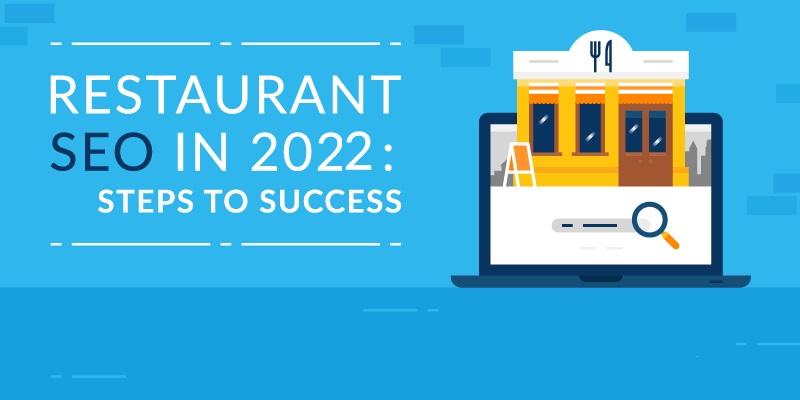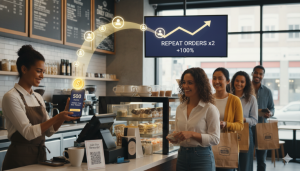SEO (Search Engine Optimization) is a fantastic strategy to increase the number of visitors to your website.
You not only increase the number of visitors to your website, but you also increase the number of customers that visit your restaurant.
Restaurant SEO is critical in today’s environment from a commercial aspect. Restaurant SEO may help you build your business and get loyal customers who would not have known about your restaurant otherwise.
For both in-person eating and carry-out choices, increasing exposure at the local level is critical right now.
There are several paid ads, partner services, and referral possibilities for getting visitors. Climbing to the top of Google’s organic search results, on the other hand, is a cost-effective approach to getting the most relevant and direct traffic to convert into customers.
Although SEO may appear technical, it does not have to be. You can take a few basic steps right now to convert your online menu into a key traffic driver.
Optimizing Your Online Menu with Restaurant SEO
Keyword Planning and Menu Item Names
Keyword planning lays out the target search phrases you want your restaurant’s website to rank for.
These keywords can be single words, but they’re more likely to be a combination of two, three, or more, such as “the best pizza in London.”
When it comes to keyword research, you should divide your goals into three categories. Broad restaurant phrases, specialty keywords, and branded keywords.
Broad restaurant phrases are general yet important restaurant phrases like “restaurants in Qatar,” “top Chicago dining place,” and so on.
Specialty keywords are terms that are exclusive to your restaurant’s offerings. Consider phrases like “pizza parties Detroit,” “pizza Halloween bargains,” and so on.
Branded keywords entail optimizing for your restaurant’s name and related terms. It’s common for restaurants to have Yelp show in the top few results for their restaurant name instead of their own.
It’s not always simple to develop the proper keywords for your menu items and descriptions.
While giving your menu items original names is entertaining, it might make it challenging for customers and search engines to locate you.
It’s critical to speak the same language as your customers do while searching for you online. You’ll want to figure out what your customers are looking for on Google.
Meta Descriptions
Use the same keywords when creating your menu description once you’ve defined your keywords and menu item names.
This process validates your keywords and informs search engines of your intentions.
In search engine results, the Meta description is the brief description that appears beneath your title. It helps to increase your overall click-through rate. Meta descriptions are your opportunity to promote your menu item and explain what your page is all about.
Your description should entice a potential customer to learn more about your dish.
In your Meta description, use terms from your on-page description. Use your keywords to create a fascinating description that entices the restaurant searcher to visit your website and learn more about your food. This copy should be roughly 155 characters long.
The essential thing to know about Meta Descriptions is that they should be unique for each page.
Title Tags
The names of each page on your website are called title tags. This is an HTML tag that you may find in the head section of every webpage.
It offers search engines a hint about the website or article’s topic. It’s also the clickable blue headline that consumers view on the search engine result page.
Organic rankings are not affected by title tags. However, if you don’t have one or if it has nothing to do with the page’s topic matter, it might hinder your SEO.
Considering your title is the first thing your potential customers will see, making an excellent first impression is critical. It informs them, as well as Google, about the content of your page.
For optimum impact on search engine results, make sure to include high-performing keywords in the title.
Each title tag should be unique, yet they should all have the same focus. A decent rule of thumb for title tags is to make them brief and descriptive. Aside from keywords, the length of your title tag, which you should maintain around 70 characters, is also essential.
This limit might not be easy because you typically have a lot to say on each page but stick to the core point and you’ll be OK.
Browser windows, search engine results pages, and external websites such as social media display titles.
The page title will be seen by your website visitors. Make sure your page title includes the words Oven Roasted Filet Mignon if your menu item on this page is Oven Roasted Filet Mignon. The title tag should adequately explain the page’s content and incorporate the keywords you’ve picked.
Keep the following in mind when creating a title tag:
- Use your keywords – if there is room, use the primary and secondary keywords.
- Start with the most key terms in your title.
- Make use of the restaurant’s name.
- You can try a title tag emulator if you want to see how your title tag will appear in Google.
Why Focus on Restaurant SEO?
Now that you know how you can optimize your menu for restaurant SEO, you may be wondering why you should be taking this time to do so in the first place.
Although restaurant SEO is a long-term strategy, your restaurant has significant rewards if you put in the effort.
Prominence of Google
When it comes to finding information, Google has become the go-to source.
Where to go, what to do, and, most importantly, where to eat are all provided.
As a result, it’s vital that your restaurant does all necessary to appear towards the top of the search results page.
The Online Conversation
Although word of mouth has always been an excellent strategy to raise brand awareness, how it occurs has evolved.
People share information online, which might include a link to your website.
SEO may help you generate links to your website, which will help Google rank it higher.
Customers Search Locally
Customers prefer to dine at local establishments for the sake of convenience and save time, effort, and money.
Local SEO is included in a solid SEO plan so that your customers may find you if they search locally.
Searching Habits
You can boost your restaurant’s visibility and notoriety by ranking higher on the search engine result page.
Most people don’t bother scrolling past the first few Google results, and even fewer get past the first page.
If your restaurant does not appear on the top page, those customers will never know about it.
Popularity of Smartphones
Since so many people choose to browse the web and do searches on their phones, your website must be mobile-friendly.
Mobile optimization is included in good SEO services, ensuring that your website performs effectively on mobile phones and PCs.
A mobile-friendly website will also rank higher in search results.
Free Marketing
Unlike paid search advertisements, SEO is virtually free or “organic” and produces long-term results.
Your customers will click on your website because it appears first in the search results, not because you paid Google for it to be first.
As a result, if you’ve established a solid SEO plan, you’ll be able to profit from it long after it’s been deployed. SEO produces long-term, long-lasting results.
You Need SEO to Stay Ahead of Competition
You can bet that if you aren’t using all of SEO’s potential benefits, someone else is.
If your competitors use SEO, their websites will appear higher in search results than yours, and customers will click on their website rather than yours.
Having an SEO plan gives you a massive edge over your competition, yet it won’t cost you.
Improve Customer Engagement
Gone are the days when you could type in a search keyword and receive a list of static websites with no interaction.
Google may now display information such as the address, company information, and restaurant rating directly from the search engine results page.
When people search for your restaurant, an SEO plan will incorporate this into your website to see all of the information they need.
Social Media and SEO are Connected
Customers will look for your brand in Google if you use social media to raise brand awareness. And customers will find your website on the first page of Google if you use SEO.
Impact on Brand Reputation
SEO isn’t only about improving your search engine rankings; it’s also about improving your customers’ whole online experience.
Customers will better appreciate your brand if your website is more professional.
A clumsy and unprofessional website reflects poorly on your brand and sets the tone for your establishment.
Improve Your Bottom Line
A properly-optimized website for search engines draws more visitors, as well as those who are more likely to convert into leads or sales.
SEO services generate revenue for your website, and once accomplished, they continue to do so for a long time.
In Summary
It’s no longer optional for your restaurant to have a good internet presence. Customers need to discover you quickly and simply on a variety of platforms.
Restaurant SEO is the way to go.
Restaurant SEO is a method of attracting new customers to your establishment. Optimizing your website for search engine traffic might be a terrific method to augment your efforts if you want to expand your business.
People need to discover you online if you want to make sure your restaurant is packed every day – or if you’re going to maximize your delivery and carry-out business.
You must promptly win them over with an excellent website experience and motivate them to take action once they find you.
Always keep in mind that restaurant SEO is all about the customer. You’re improving the user’s complete web experience. This is the most satisfactory long-term plan and what the search engines desire.
[INSERT_ELEMENTOR id=”10819″]
Related Articles:
 Blink’s Special: Chefs Talking about Restaurant Industry in 2021 & Beyond
Blink’s Special: Chefs Talking about Restaurant Industry in 2021 & Beyond
 5 of The Best Restaurant Social Media Campaigns (New Guide)
5 of The Best Restaurant Social Media Campaigns (New Guide)
 35 Online Ordering Systems for Restaurants in 2023
35 Online Ordering Systems for Restaurants in 2023
 Inventory Management Software For Restaurant In 2023
Inventory Management Software For Restaurant In 2023
 Food Delivery Statistics: 38 Facts You Need to Know to Scale In 2021
Food Delivery Statistics: 38 Facts You Need to Know to Scale In 2021







